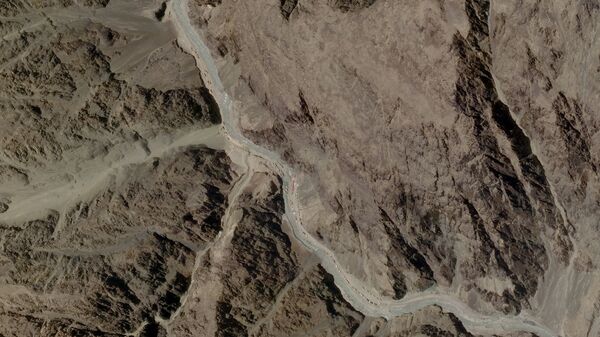Alleged satellite images emerged online on Wednesday from Galwan Valley in the Ladakh region which purportedly show a massive People's Liberation Army build-up as India and China deploy additional troops in the region.
As per the satellite images and videos compiled by Nathan Ruser, a satellite imagery expert at the Australian Strategic Policy Institute, the number of alleged Chinese structures/tents and vehicles within one kilometre of the loosely demarcated Line of Actual Control has grown from 3 to 46 (1500 percent growth) in the last month. The expert, who compiled the images from 22 May to 22 June, claimed that in the same period, the number of Indian structures decreased to 17 from 84, a decrease of 80 percent.
Satellite imagery from the Galwan Valley on June 22nd shows that 'disengagement' really isn't the word that the government should be using. This gif shows the small outpost that sparked the June 15th clashes. It has grown hugely in size. Indian troops aren't dismantling this one. pic.twitter.com/8Q78ftr3uW
— Nathan Ruser (@Nrg8000) June 24, 2020
Some sources, however, have suggested that the mentioned structures belong to the Indian Army, not China.
Contrary to reports the structures visible in latest satellite pictures are Indian not Chinese. If you missed the livestream with @nitingokhale on the gradual disengagement on LAC flashpoints watch on Twitter 👇🏾 https://t.co/cQQ8EBjxCX
— StratNewsGlobal (@StratNewsGlobal) June 24, 2020
Earlier in a day, China’s foreign and defence ministries blamed India for the deadly Galwan Valley clash on 15 June. The defence ministry of China stated that Indian troops had crossed the Line of Control which escalated into violent clashes.
Previously, the two countries agreed to “implement the understanding on disengagement and de-escalation that was reached by the Senior Commanders on 6 June” during diplomatic level talks. While both sides agreed to maintain dialogue and promote peace and tranquility in the area, a timeline for the disengagement process wasn't finalised, the Indian Army said on 23 June.
Border conflicts are a permanent fixture of India-China relations, as the countries do not have a marked border but rather the so-called Line of Actual Control, created after the 1962 war between the two nations. However, tensions have recently become more strained as a result of skirmishes between the countries' border forces starting in May.


